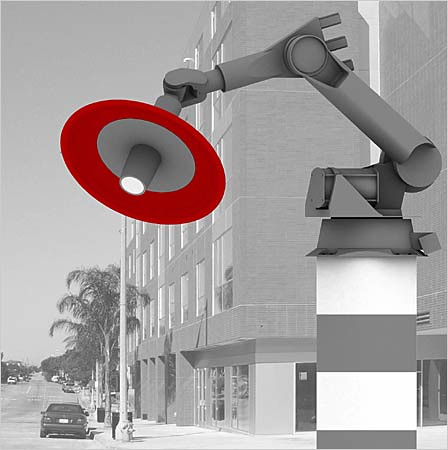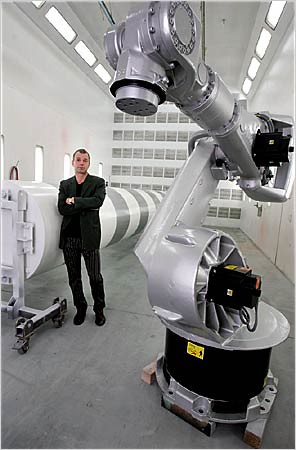A Lonely Cyclops

Artist Christian Moeller has designed a robot that “stands on this pedestal with a light in his hand and shines it around for no reason, like a lonely fellow,” he says, “lost in the corner, all day, all night.”
Playing with experiential notions of flood lights and surveillance Mojo’s massive arm retracts and aims its unsettling light with “machine-precision vigilance” at people whose motion is detected within a range calculated by two CCTV cameras fixed nearby.
This installation for downtown San Pedro, California builds on a body of work blurring distinctions of art and surveillance through human interaction with machinery.
He says in this New York Times article “Before we were scared of these things. Now to some extent people are embracing surveillance because it makes them feel safer.” But I wonder if his work isn’t helping that process, of accepting a surveillatopia.

He also mentions on his website for the Do Not Touch project where there was a huge warning sign on a gallery floor that told visitors ‘do not touch,’:
“It creates a conflict by tempting the visitor to do precisely what he is warned not to do. This conflict, when resolved through disobedience results in a jolting physical experience.”
In this case it was a significant electric shock.
Though, what actually metabolizes culturally as a result of this cyclopean security guard? I mean, I think this sculpture and most of his work is cool as hell, but do these projects help us become more tolerant of an omnipotent surveillance atmosphere? If rather than jolting and alerting us to the fearful cultural effect of surveillance instead making us skeptical of what some of these installations signify, are we being tempted by them for their seductive artistic appeal?
Is this futuristic appendage of panopticonism acculturating us to more prominent landscape fixtures in Big Brother's garden? Will Mojo have a kind of salesmanship effect on the public when it comes time to install these things permanently down along the border, or in Central Park, or will it provoke the opposite?
(Images via J. Emilio Flores for The New York Times, 2007.)







0 Comments:
Post a Comment
<< Home